Development of Novel Antimicrobial and Antiviral Green Synthesized Silver Nanocomposites for the Visual Detection of Fe3+ Ions
Abstract
:1. Introduction
2. Experimental Section
2.1. Chemicals
2.2. Synthesis of Silver Nanocomposites
2.3. Characterization
2.4. Antibacterial Testing
2.5. Antifungal Activity Assessments
2.6. Antiviral Activity Assessments
2.6.1. TCID50 Method and Preparation of Growth Medium
2.6.2. Preparation of Viruses
Influenza Virus
Feline Calicivirus
2.6.3. Principle
2.7. Detection of Fe3+ Ion
3. Results and Discussion
3.1. Synthesis of Silver Nanocomposites
3.2. Antibacterial Testing
3.3. Antifungal and Antiviral Activity of Treated Samples
3.4. Visual Detection of Ferric Ions
4. Conclusions
Author Contributions
Funding
Institutional Review Board Statement
Informed Consent Statement
Data Availability Statement
Acknowledgments
Conflicts of Interest
References
- Sall, M.L.; Diaw, A.K.D.; Gningue-Sall, D.; Efremova Aaron, S.; Aaron, J.J. Toxic heavy metals: Impact on the environment and human health, and treatment with conducting organic polymers, a review. Environ. Sci. Pollut. Res. 2020, 27, 29927–29942. [Google Scholar] [CrossRef]
- Bhargava, P.; Gupta, N.; Vats, S.; Goel, R. Health Issues and Heavy Metals. Austin J. Environ. Toxicol. 2017, 3, 3018. [Google Scholar]
- Kohzadi, S.; Ramazanzade, R.; Loqmani, H.; Shakib, P.; Ghaderzadeh, H.; Khasi, B.; Reshadmanesh, N. Assessing the efficiency of floor disinfection on bacterial decontamination in sanandaj governmental hospitals. J. Adv. Environ. Health Res. 2018, 6, 44–51. [Google Scholar] [CrossRef]
- Mulens-Arias, V.; Rojas, J.M.; Barber, D.F. The intrinsic biological identities of iron oxide nanoparticles and their coatings: Unexplored territory for combinatorial therapies. Nanomaterials 2020, 10, 837. [Google Scholar] [CrossRef] [PubMed]
- Sousa Gerós, A.; Simmons, A.; Drakesmith, H.; Aulicino, A.; Frost, J.N. The battle for iron in enteric infections. Immunology 2020, 161, 186–199. [Google Scholar] [CrossRef]
- Torti, S.V.; Torti, F.M. Iron: The cancer connection. Mol. Aspects Med. 2020, 75, 100860. [Google Scholar] [CrossRef] [PubMed]
- Walker, E.M.; Walker, S.M. Effects of iron overload on the immune system. Ann. Clin. Lab. Sci. 2000, 30, 354–365. [Google Scholar]
- Puntarulo, S. Iron, oxidative stress and human health. Mol. Aspects Med. 2005, 26, 299–312. [Google Scholar] [CrossRef]
- Georgieff, M.K. Iron deficiency in pregnancy. Am. J. Obstet. Gynecol. 2020, 223, 516–524. [Google Scholar] [CrossRef] [PubMed]
- Pipattanawarothai, A.; Trakulsujaritchok, T. Hybrid polymeric chemosensor bearing rhodamine derivative prepared by sol-gel technique for selective detection of Fe3+ ion. Dye. Pigment. 2020, 173, 107946. [Google Scholar] [CrossRef]
- Mitra, A.; Ramanujam, B.; Rao, C.P. 1-(d-Glucopyranosyl-2′-deoxy-2′-iminomethyl)-2-hydroxynaphth alene as chemo-sensor for Fe3+ in aqueous HEPES buffer based on colour changes observable with the naked eye. Tetrahedron Lett. 2009, 50, 776–780. [Google Scholar] [CrossRef]
- Zhang, Y.; Qiu, Y.; Zhou, K.; Zhang, K.; Wang, L.; Zeng, J.; Ji, B.; Gao, D.; Xia, Z.; Fu, Q. Self-exothermic redox reaction-driven green synthesis of fluorescent poly(dopamine) nanoparticles for rapid and visual detection of Fe3+. Dye. Pigment. 2020, 183, 108692. [Google Scholar] [CrossRef]
- Laglera, L.M.; Monticelli, D. Iron detection and speciation in natural waters by electrochemical techniques: A critical review. Curr. Opin. Electrochem. 2017, 3, 123–129. [Google Scholar] [CrossRef]
- Yuniarni, D.R.; Pratiwi, N.I.; Umar, A.; Imawan, C. Synthesis of silver nanoparticles (AgNPs) using Sodium Chloride (NaCl) for Iron (III) ions detection based on colorimetric and optical changes. J. Phys. Conf. Ser. 2020, 1528, 012062. [Google Scholar] [CrossRef]
- Xue, X.; Gao, M.; Rao, H.; Luo, M.; Wang, H.; An, P.; Feng, T.; Lu, X.; Xue, Z.; Liu, X. Photothermal and colorimetric dual mode detection of nanomolar ferric ions in environmental sample based on in situ generation of prussian blue nanoparticles. Anal. Chim. Acta 2020, 1105, 197–207. [Google Scholar] [CrossRef]
- Desai, M.P.; Patil, R.V.; Harke, S.S.; Pawar, K.D. Bacterium mediated facile and green method for optimized biosynthesis of gold nanoparticles for simple and visual detection of two metal ions. J. Clust. Sci. 2021, 32, 341–350. [Google Scholar] [CrossRef]
- Ali, A.; Sattar, M.; Hussain, F.; Tareen, M.H.K.; Militky, J.; Noman, M.T. Single-step green synthesis of highly concentrated and stable colloidal dispersion of core-shell silver nanoparticles and their antimicrobial and ultra-high catalytic properties. Nanomaterials 2021, 11, 1007. [Google Scholar] [CrossRef]
- Ayyob, M.; Ahmad, I.; Hussain, F.; Bangash, M.K.; Awan, J.A.; Jaubert, J.-N. A new technique for the synthesis of lanthanum substituted nickel cobaltite nanocomposites for the photo catalytic degradation of organic dyes in wastewater. Arab. J. Chem. 2020, 13, 6341–6347. [Google Scholar] [CrossRef]
- Awan, J.A.; Rehman, S.U.; Bangash, M.K.; Ali, U.; Asad, M.; Hussain, F.; Jaubert, J.-N. Development and characterization of electrospun curcumin-loaded antimicrobial nanofibrous membranes. Text. Res. J. 2020, 91, 1478–1485. [Google Scholar] [CrossRef]
- Gajanan, K.; Tijare, S.N. Applications of nanomaterials. Mater. Today Proc. 2018, 5, 1093–1096. [Google Scholar] [CrossRef]
- Siwal, S.S.; Zhang, Q.; Devi, N.; Thakur, V.K. Carbon-based polymer nanocomposite for high-performance energy storage applications. Polymers 2020, 12, 505. [Google Scholar] [CrossRef] [Green Version]
- Hussain, F.; Jeong, J.; Park, S.; Jeong, E.; Kang, S.-J.; Yoon, K.; Kim, J. Fabrication and characterization of a novel terpolyester film: An alternative substrate polymer for flexible electronic devices. Polymer 2020, 210, 123019–123026. [Google Scholar] [CrossRef]
- Hussain, F.; Park, S.; Jeong, J.; Kang, S.; Kim, J. Structure–property relationship of poly(cyclohexane 1,4-dimethylene terephthalate) modified with high trans-1,4-cyclohexanedimethanol and 2,6-naphthalene dicarboxylicacid. J. Appl. Polym. Sci. 2020, 137, 48950. [Google Scholar] [CrossRef]
- Shen, W.; Zhang, X.; Huang, Q.; Xu, Q.; Song, W. Preparation of solid silver nanoparticles for inkjet printed flexible electronics with high conductivity. Nanoscale 2014, 6, 1622–1628. [Google Scholar] [CrossRef]
- Hussain, F.; Park, S.; Jeong, J.; Jeong, E.; Kang, S.; Yoon, K.; Kim, J. Fabrication and characterization of poly(1,4-cyclohexanedimthylene terephthalate-co-1,4-cyclohxylenedimethylene 2,6-naphthalenedicarboxylate) (PCTN) copolyester film: A novel copolyester film with exceptional performances for next generation. J. Appl. Polym. Sci. 2021, 138, 49840. [Google Scholar] [CrossRef]
- Maduraiveeran, G.; Jin, W. Nanomaterials based electrochemical sensor and biosensor platforms for environmental applications. Trends Environ. Anal. Chem. 2017, 13, 10–23. [Google Scholar] [CrossRef]
- Faupel, F.; Zaporojtchenko, V.; Strunskus, T.; Elbahri, M. Metal-polymer nanocomposites for functional applications. Adv. Eng. Mater. 2010, 12, 1177–1190. [Google Scholar] [CrossRef]
- Li, D.; He, Q.; Li, J. Smart core/shell nanocomposites: Intelligent polymers modified gold nanoparticles. Adv. Colloid Interface Sci. 2009, 149, 28–38. [Google Scholar] [CrossRef]
- Ghosh Chaudhuri, R.; Paria, S. Core/shell nanoparticles: Classes, properties, synthesis mechanisms, characterization, and applications. Chem. Rev. 2012, 112, 2373–2433. [Google Scholar] [CrossRef]
- Kim, H.J.; Choi, Y.S.; Lim, M.Y.; Jung, K.H.; Kim, D.G.; Kim, J.J.; Kang, H.; Lee, J.C. Reverse osmosis nanocomposite membranes containing graphene oxides coated by tannic acid with chlorine-tolerant and antimicrobial properties. J. Memb. Sci. 2016, 514, 25–34. [Google Scholar] [CrossRef]
- Fei, J.; Zhao, J.; Du, C.; Wang, A.; Zhang, H.; Dai, L.; Li, J. One-pot ultrafast self-assembly of autofluorescent polyphenol-based core@shell nanostructures and their selective antibacterial applications. ACS Nano 2014, 8, 8529–8536. [Google Scholar] [CrossRef]
- Andjelković, M.; Van Camp, J.; De Meulenaer, B.; Depaemelaere, G.; Socaciu, C.; Verloo, M.; Verhe, R. Iron-chelation properties of phenolic acids bearing catechol and galloyl groups. Food Chem. 2006, 98, 23–31. [Google Scholar] [CrossRef]
- Ye, Q.; Zhou, F.; Liu, W. Bioinspired catecholic chemistry for surface modification. Chem. Soc. Rev. 2011, 40, 4244–4258. [Google Scholar] [CrossRef]
- Zeng, T.; Zhang, X.; Guo, Y.; Niu, H.; Cai, Y. Enhanced catalytic application of Au@polyphenol-metal nanocomposites synthesized by a facile and green method. J. Mater. Chem. A 2014, 2, 14807–14811. [Google Scholar] [CrossRef]
- Hussain, F.; Shaban, S.M.; Kim, J.; Kim, D.-H. One-pot synthesis of highly stable and concentrated silver nanoparticles with enhanced catalytic activity. Korean J. Chem. Eng. 2019, 36, 988–995. [Google Scholar] [CrossRef]
- Crandell, R.A.; Fabricant, C.G.; Nelson, W.A. Development, characterization, and viral susceptibility of a feline (Felis catus) renal cell line (CRFK). In Vitro 1973, 9, 176–185. [Google Scholar] [CrossRef]
- Takada, K.; Kawakami, C.; Fan, S.; Chiba, S.; Zhong, G.; Gu, C.; Shimizu, K.; Takasaki, S.; Sakai-Tagawa, Y.; Lopes, T.J.S.; et al. A humanized MDCK cell line for the efficient isolation and propagation of human influenza viruses. Nat. Microbiol. 2019, 4, 1268–1273. [Google Scholar] [CrossRef]
- Allen, J.D.; Ross, T.M. H3N2 influenza viruses in humans: Viral mechanisms, evolution, and evaluation. Hum. Vaccines Immunother. 2018, 14, 1840–1847. [Google Scholar] [CrossRef] [PubMed] [Green Version]
- Evermann, J.F.; Kennedy, M.A. Chapter 16—Viral Infections, in Small Animal Pediatrics; Peterson, M.E., Kutzler, M.A., Eds.; W.B. Saunders: Saint Louis, MO, USA, 2011; pp. 119–129. [Google Scholar]
- Chen, Z.; Wang, C.; Chen, J.; Li, X. Biocompatible, functional spheres based on oxidative coupling assembly of green tea polyphenols. J. Am. Chem. Soc. 2013, 135, 4179–4182. [Google Scholar] [CrossRef]
- Hussain, F.; Khurshid, M.F.; Masood, R.; Ibrahim, W. Developing antimicrobial calcium alginate fibres from neem and papaya leaves extract. J. Wound Care 2017, 26, 778–783. [Google Scholar] [CrossRef]
- Ali, A.; Nguyen, N.H.A.; Baheti, V.; Ashraf, M.; Militky, J.; Mansoor, T.; Noman, M.T.; Ahmad, S. Electrical conductivity and physiological comfort of silver coated cotton fabrics. J. Text. Inst. 2018, 109, 620–628. [Google Scholar] [CrossRef]
- Ali, A.; Baheti, V.; Militky, J.; Khan, Z. Utility of silver-coated fabrics as electrodes in electrotherapy applications. J. Appl. Polym. Sci. 2018, 135, 46357. [Google Scholar] [CrossRef]
- Feng, Q.L.; Wu, J.; Chen, G.Q.; Cui, F.Z.; Kim, T.N.; Kim, J.O. A mechanistic study of the antibacterial effect of silver ions on Escherichia coli and Staphylococcus aureus. J. Biomed. Mater. Res. 2000, 52, 662–668. [Google Scholar] [CrossRef]
- Jung, W.K.; Koo, H.C.; Kim, K.W.; Shin, S.; Kim, S.H.; Park, Y.H. Antibacterial activity and mechanism of action of the silver ion in Staphylococcus aureus and Escherichia coli. Appl. Environ. Microbiol. 2008, 74, 2171–2178. [Google Scholar] [CrossRef] [Green Version]
- International Organization for Standardization. ISO 18184: Textiles-Determination of Antiviral Activity of Textile Products; ISO: Geneva, Switzerland, 2014. [Google Scholar]
- Mehrbod, P.; Motamed, N.; Tabatabaian, M.; Soleimani, E.R.; Amini, E.; Shahidi, M.; Kheiri, M.T. In vitro antiviral effect of “nanosilver” on influenza virus. J. Pharm. Sci. 2009, 17, 88–93. [Google Scholar]
- Xiang, Z.C.; Chen, D.X.; Pang, L. Inhibitory effects of silver nanoparticles on H1N1 influenza A virus in vitro. J. Virol. Methods. 2011, 178, 137–142. [Google Scholar] [CrossRef]
- Elechiguerra, J.L.; Burt, J.L.; Morones, J.R.; Camacho-Bragado, A.; Gao, X.; Lara, H.H.; Yacaman, M.J. Interaction of silver nanoparticles with HIV-1. J. Nanobiotechnology 2005, 3, 3–6. [Google Scholar] [CrossRef] [Green Version]
- Lu, L.; Sun, R.W.; Chen, R.; Hui, C.K.; Ho, C.M.; Luk, J.M.; Lau, G.K.; Che, C.M. Silver nanoparticles inhibit hepatitis B virus replication. Antivir. Ther. 2008, 13, 253–262. [Google Scholar] [PubMed]
- Lara, H.H.; Garza-Treviño, E.N.; Ixtepan-Turrent, L. Silver nanoparticles are broad-spectrum bactericidal and virucidal compounds. J. Nanobiotechnology 2011, 9, 30. [Google Scholar] [CrossRef] [Green Version]
- Yunsuo, K.; Xiang, W.; Xike, T.; Chao, Y.; Yong, L.; Yulun, N. Silica-embedded CdTe quantum dots functionalized with rhodamine derivative for instant visual detection of ferric ions in aqueous media. J. Photochem. Photobio A Chem. 2019, 372, 140–146. [Google Scholar]
- Haolan, W.; Lian, Y.; Linfeng, C.; Fang, X.; Hongyu, G. Visual determination of ferric ions in aqueous solution based on a high selectivity and sensitivity ratiometric fluorescent nanosensor. Anal. Methods 2017, 9, 5935–5942. [Google Scholar]
- Shaochen, Z.; Mei, Z.; Fangyuan, Y.; Fu, W.; Chuanyi, W. Facile synthesis of water soluble fluorescent metal (Pt, Au, Ag and Cu) quantum clusters for selective detection of Fe3+ ions as both fluorescent and colorimetric probe. J. Mater. Chem. C 2017, 5, 2466–2473. [Google Scholar]

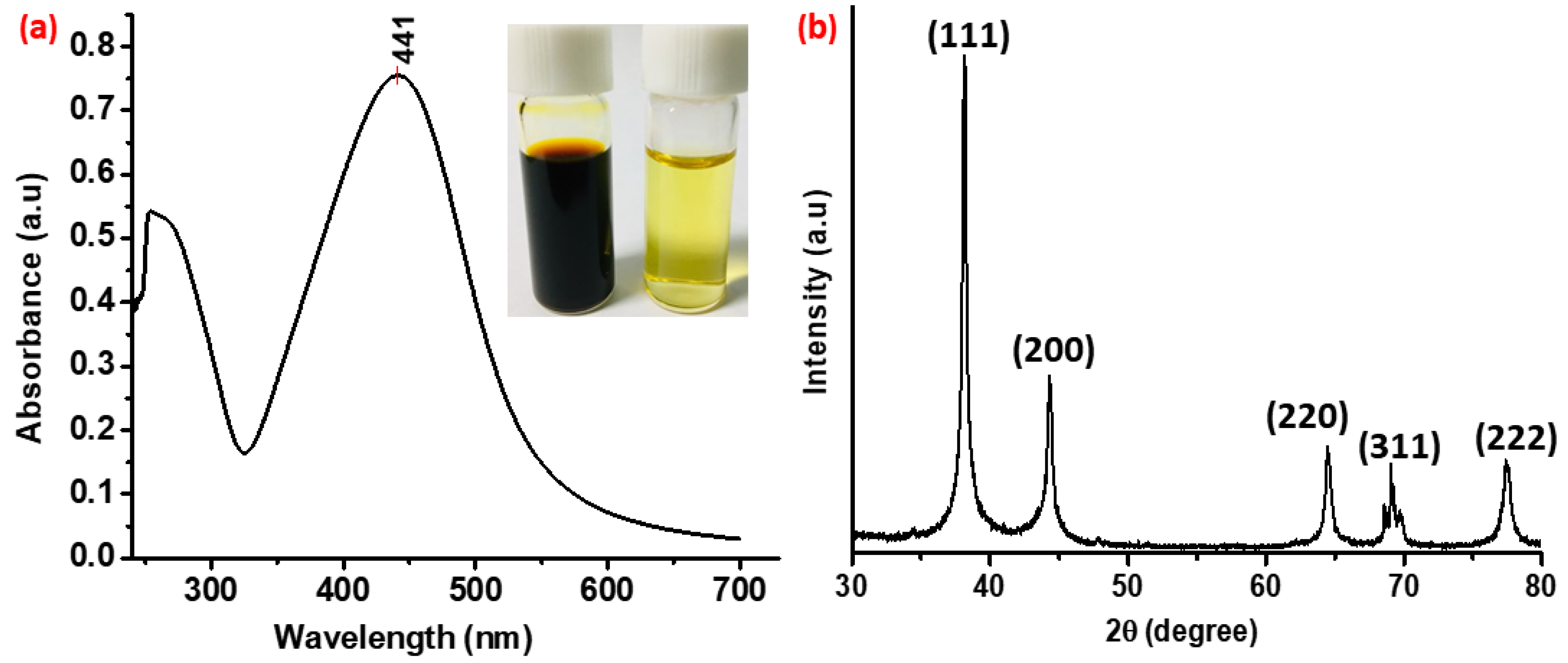
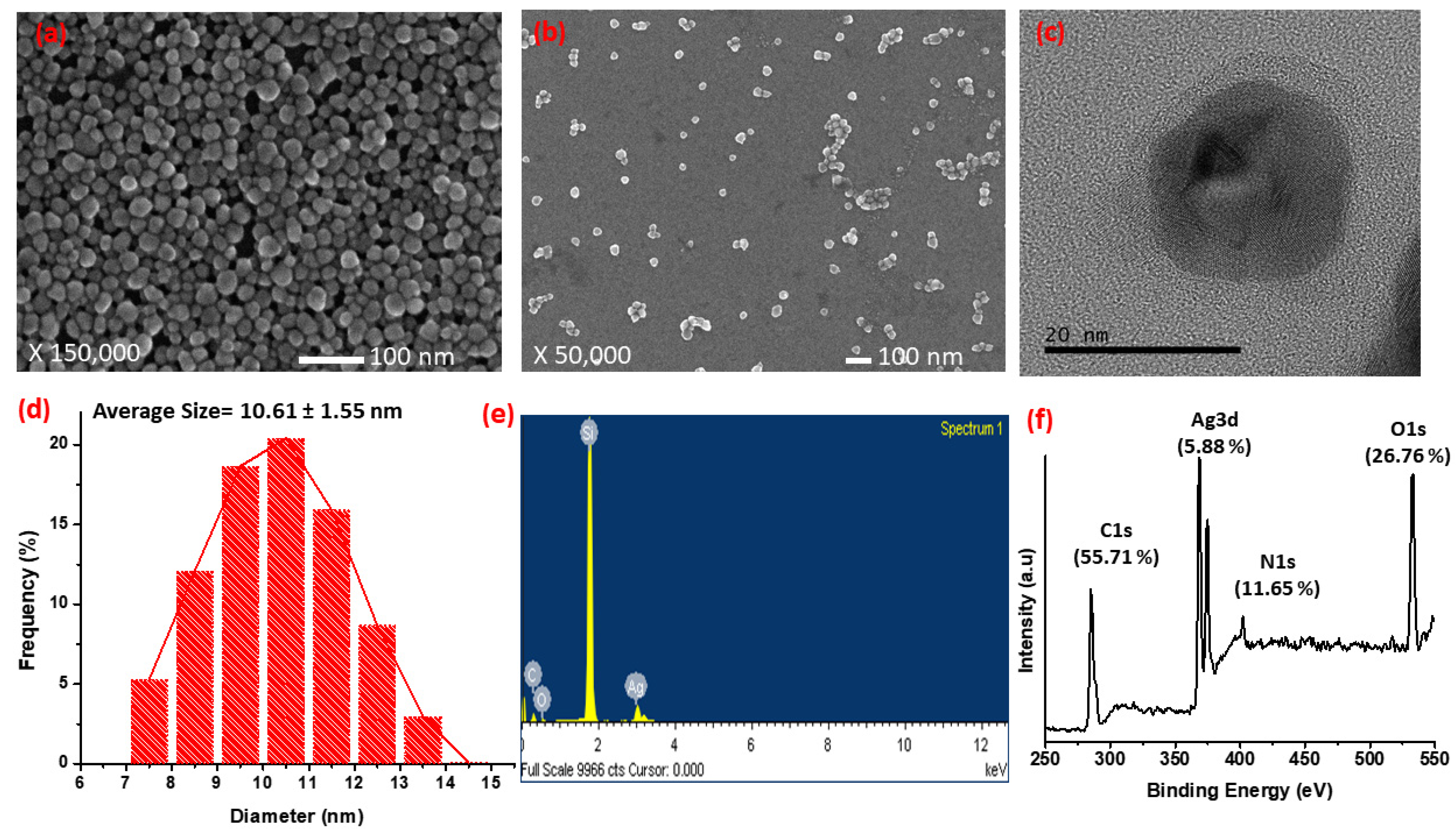



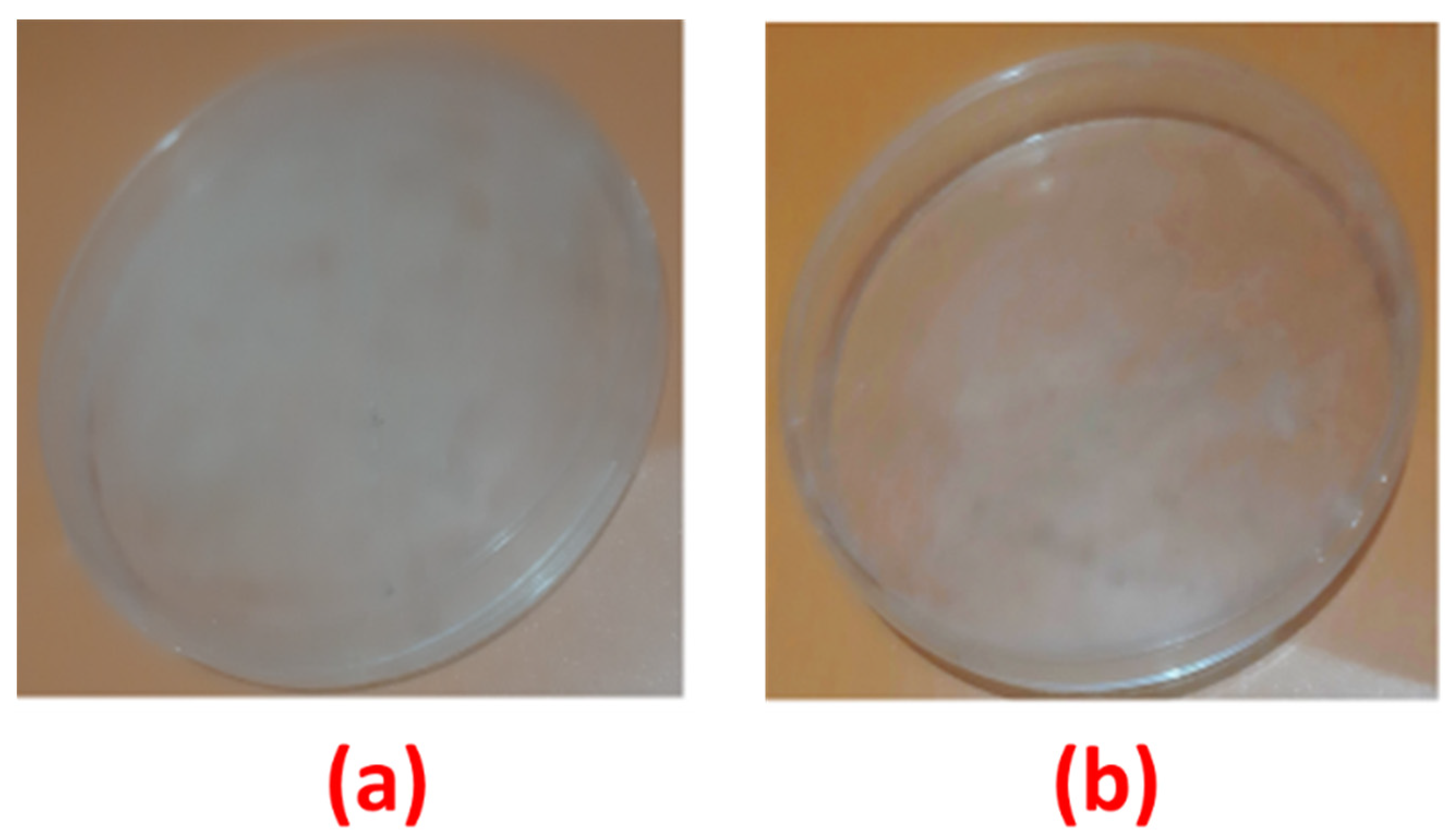
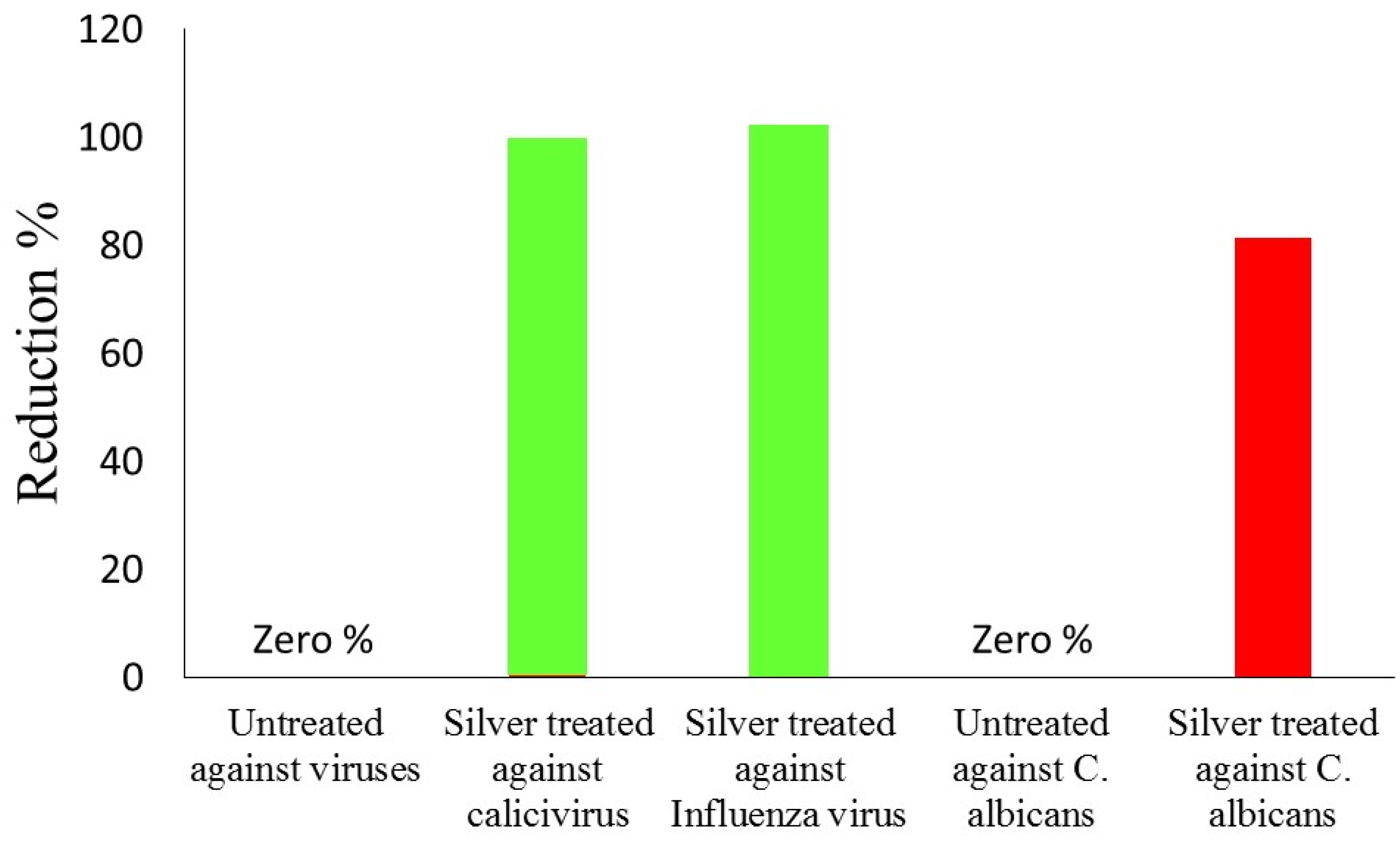
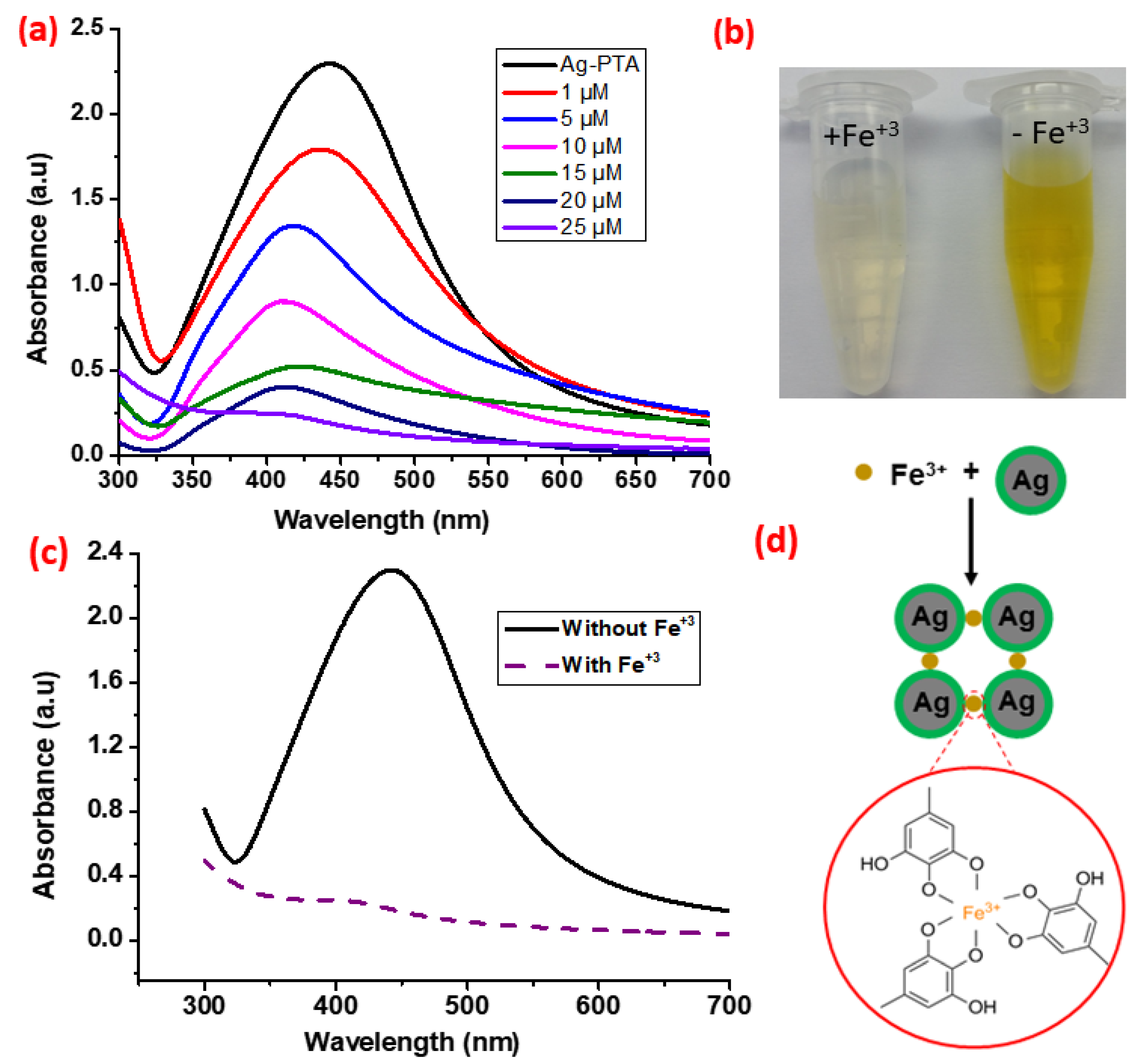


| Host cell | The Crandell–Rees feline kidney (CRFK) cell ATCC CCL-94 | Madin–Darby canine kidney (MDCK) cell ATCC CCL-34 |
| Virus strain | Influenza A virus (H3N2) AATCC VR-1679 | Feline calicivirus (FCV) F-9 strain AATCC VR-782 |
| Growth medium | EMEM | RPMI 1640 |
| Maintenance medium | Grade 3 water (800 mL), kanamycin sulphate (60 mg) Eagle’s minimum essential medium (9.53 g) | |
| No. of washes of sample | 20 cycles | |
| Wash standard | Normal wash ISO 6330-2012 | |
| Washing temperature | 40 °C | |
| Drying standard | Tumbled dry | |
| Contact time | 2 h | |
| Bacteria | Virus | Yeast |
|---|---|---|
| Staphylococcus aureus | Feline calicivirus | Candida albicans |
| Escherichia coli | Influenza virus |
| Name | Peak Binding Energy (eV) | Height of Counts per Second (CPS) | Peak Area (CPS.eV) | Atomic % |
|---|---|---|---|---|
| Ag3d | 368.37 | 43,720.62 | 229,982 | 5.85 |
| O1s | 532.79 | 33,415.45 | 125,626.3 | 26.79 |
| C1s | 285.41 | 24,781.04 | 102,895.8 | 55.7 |
| N1s | 401.9 | 5227.99 | 34,148.99 | 11.66 |
| Sr. No | Frequency (cm−1) | Functional Group | Sr. No | Frequency (cm−1) | Functional Group |
|---|---|---|---|---|---|
| 1 | 3400 | Carboxylic acid, phenols | 2 | 2932 | C–H asymmetric stretching |
| 3 | 2841 | C–H symmetric stretching | 4 | 1582 | Carboxylic acid |
| 5 | 1415 | C–O/C–H bending | 6 | 1220 | Ether |
| 7 | 1096 | C–O stretching of hydroxyl group | 8 | 500–850 | Aromatic rings |
| Sample | Amount of Loaded Silver Nanocomposites (mm) | Reduction %age |
|---|---|---|
| 1 | 0 | 0 |
| 2 | 0.5 | 9.23 |
| 3 | 0.75 | 22.34 |
| 4 | 1 | 46.63 |
| 5 | 1.25 | 66.45 |
| 6 | 1.5 | 76.67 |
| Name of Virus | Sample | Toxicity Titer (TCID50 per Carrier) | Mean Titer (TCID50 per Carrier) | Mean Log 10 (TCID50 per Carrier) | Log 10 Reduction | Reduction % |
|---|---|---|---|---|---|---|
| Feline calicivirus | Control | 5.5 × 105 | 5.43 × 105 | 5.73 | 2.19 | 99.45% |
| 4.5 × 105 | ||||||
| 6.3 × 105 | ||||||
| Test sample | 3.8 × 105 | 3.5 × 103 | 3.54 | |||
| 2.4 × 105 | ||||||
| 4.3 × 105 | ||||||
| Influenza virus | Control | 6.7 × 105 | 5.53 × 105 | 5.74 | 2.3 | 99.52% |
| 4.5 × 105 | ||||||
| 5.4 × 105 | ||||||
| Test sample | 2.1 × 105 | 2.8 × 103 | 3.44 | |||
| 4.4 × 105 | ||||||
| 1.9 × 105 |
| Sr. No | Element | Weight % | Atomic % |
|---|---|---|---|
| 1 | O K | 9.84 | 17.43 |
| 3 | Si K | 68.95 | 69.61 |
| 5 | Cl K | 11.01 | 8.81 |
| 7 | Fe K | 6.01 | 3.05 |
| 8 | Ag L | 4.20 | 1.10 |
| Total | 100 | ||
Publisher’s Note: MDPI stays neutral with regard to jurisdictional claims in published maps and institutional affiliations. |
© 2021 by the authors. Licensee MDPI, Basel, Switzerland. This article is an open access article distributed under the terms and conditions of the Creative Commons Attribution (CC BY) license (https://creativecommons.org/licenses/by/4.0/).
Share and Cite
Ali, A.; Hussain, F.; Attacha, S.; Kalsoom, A.; Qureshi, W.A.; Shakeel, M.; Militky, J.; Tomkova, B.; Kremenakova, D. Development of Novel Antimicrobial and Antiviral Green Synthesized Silver Nanocomposites for the Visual Detection of Fe3+ Ions. Nanomaterials 2021, 11, 2076. https://doi.org/10.3390/nano11082076
Ali A, Hussain F, Attacha S, Kalsoom A, Qureshi WA, Shakeel M, Militky J, Tomkova B, Kremenakova D. Development of Novel Antimicrobial and Antiviral Green Synthesized Silver Nanocomposites for the Visual Detection of Fe3+ Ions. Nanomaterials. 2021; 11(8):2076. https://doi.org/10.3390/nano11082076
Chicago/Turabian StyleAli, Azam, Fiaz Hussain, Safira Attacha, Ambreen Kalsoom, Waseem Akhtar Qureshi, Muhammad Shakeel, Jiri Militky, Blanka Tomkova, and Dana Kremenakova. 2021. "Development of Novel Antimicrobial and Antiviral Green Synthesized Silver Nanocomposites for the Visual Detection of Fe3+ Ions" Nanomaterials 11, no. 8: 2076. https://doi.org/10.3390/nano11082076
APA StyleAli, A., Hussain, F., Attacha, S., Kalsoom, A., Qureshi, W. A., Shakeel, M., Militky, J., Tomkova, B., & Kremenakova, D. (2021). Development of Novel Antimicrobial and Antiviral Green Synthesized Silver Nanocomposites for the Visual Detection of Fe3+ Ions. Nanomaterials, 11(8), 2076. https://doi.org/10.3390/nano11082076








